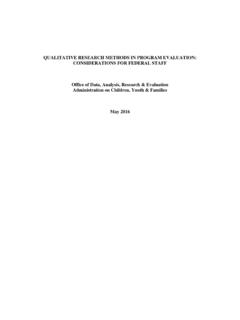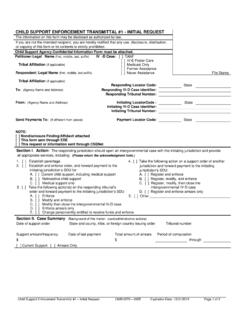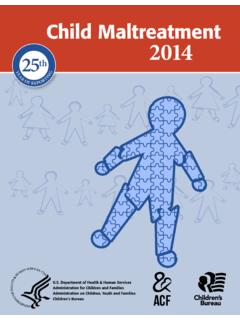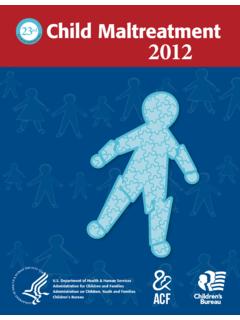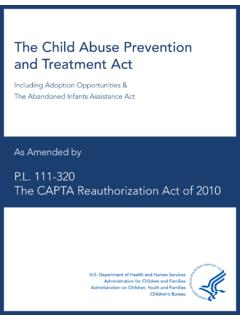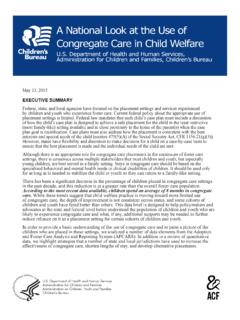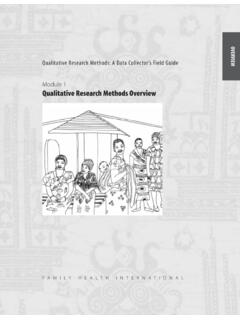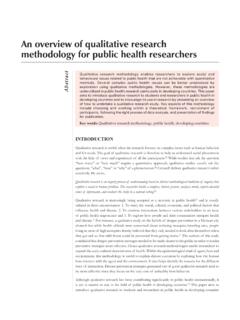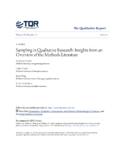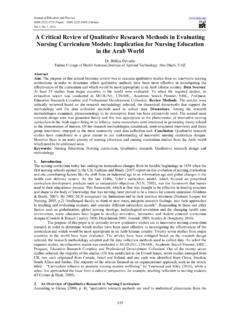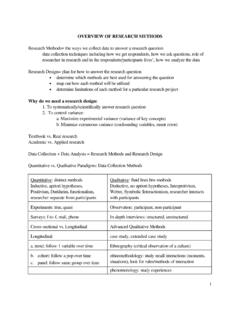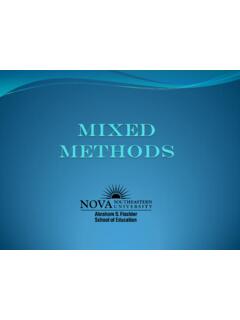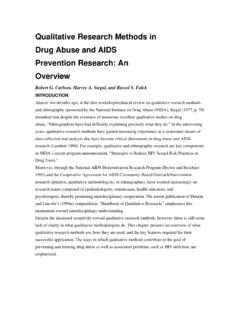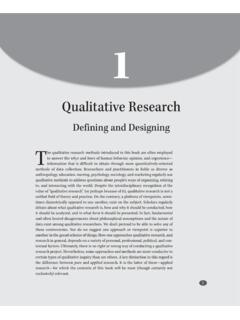Transcription of Qualitative Research Methods in Program Evaluation ...
1 Qualitative Research Methods IN Program Evaluation : CONSIDERATIONS FOR FEDERAL STAFF Office of Data, Analysis, Research & Evaluation Administration on Children, Youth & Families May 2016 Table of Contents EXECUTIVE SUMMARY .. i INTRODUCTION .. 1 PART ONE: DECIDING WHEN TO USE Qualitative 3 What are Qualitative Methods ? .. 3 The Role of Qualitative Methods in Program Evaluation .. 4 TEXT BOX 1: The Role of Qualitative Methods in Program Evaluation .. 6 Summary .. 7 PART TWO: GETTING STARTED .. 8 Researcher Experience .. 8 Questions to ask about researcher credibility .. 9 Budgeting and Time Planning .. 9 Questions to ask about time and cost estimates .. 11 Summary .. 11 PART THREE: A BRIEF PRIMER ON Qualitative Methods .. 12 Research Design: The Structure of the Study .. 12 Questions to ask about Research design .. 13 Sampling: What Gets Measured .. 14 Sampling Strategies in Qualitative Research .. 14 Sample Size .. 15 Questions to ask about 16 Qualitative Data Collection: Methods and Other 16 Interviews and Focus 17 Asking Open-Ended Questions.
2 18 Capturing Interview Data .. 19 Qualitative Observation .. 19 Document Review .. 20 On-Site Data Collection and Researcher Bias .. 20 A Few Words About Data Collection By Program Staff .. 22 Questions to ask about data collection .. 23 Qualitative Data Analysis .. 24 TEXT BOX 4 overview of the Qualitative Data Analysis Procedures .. 25 Inter-Rater Reliability .. 26 Questions to ask about Qualitative data analysis .. 26 Summary .. 27 PART FOUR: THE CREDIBILITY OF Qualitative FINDINGS .. 28 Internal Validity: Ruling Out Alternative Explanations .. 28 Rival Conclusions .. 29 Contrasting and Disconfirming/Negative Cases .. 30 Triangulation .. 31 Getting Feedback from Participants/Informants .. 32 Questions to ask about internal validity .. 32 External Validity: Generalizing the Findings .. 33 Sample-to-population extrapolation .. 34 Case-to-case transfer .. 35 Analytic generalization .. 35 Summary .. 36 Questions to ask about generalizability .. 36 CONCLUSION.
3 37 REFERENCES .. 38 EXECUTIVE SUMMARY Qualitative Research Methods can play a powerful role in Program Evaluation , but they frequently are misunderstood and poorly implemented, giving rise to the idea that they are just not as rigorous and credible as quantitative Methods . That is not true, but Qualitative Methods are less standardized than are quantitative Methods , and that makes determining their appropriate use and assessing their quality more difficult for federal staff overseeing Program Evaluation projects that include a Qualitative component. This document was written to support federal Program officers, particularly those who have not had formal Research training, as they develop and oversee projects that include Program evaluations that use Qualitative Methods . Divided into four parts, this paper begins with the decision to include Qualitative Methods (or not) in a contemplated project. This first section defines Qualitative Methods , distinguishes them from quantitative Research Methods , and outlines the roles Qualitative approaches can play in Program Evaluation .
4 This portion of the document will be particularly useful as a project or a funding announcement is being developed. The second section of the paper takes up a couple of early considerations, once the decision to incorporate Qualitative Methods has been made: How to identify an evaluator with the requisite experience in these Methods and addressing some time and cost considerations that are particular to Qualitative Research . These points will be helpful both in drafting the funding announcement and in reviewing applications. The third section of the paper provides a brief overview of Qualitative Research Methods addressing Research design, sampling, data collection, and data analysis. The idea is to provide some familiarity with concepts and terminology that will help federal staff communicate more effectively with evaluators as the project progresses; this section also may be of use in evaluating proposals that include Program Evaluation . Finally, the document takes up how to assess the credibility of Qualitative findings and conclusions, addressing both internal and external validity.
5 Although the goal of obtaining credible findings drives any Research project from its inception, it may be easier to follow the discussion of credibility if the reader has received some grounding in Qualitative Research Methods . Throughout this document are questions federal staff can ask themselves or their evaluators to aid decision-making as well as to press evaluators to be explicit about their methodological choices, time-planning, and budgeting. 1 INTRODUCTION This document has been prepared for staff charged with overseeing federally-funded Program evaluations that include the collection and analysis of Qualitative data. The information is organized and presented in four parts to allow you to get quickly to the information you need, depending on your level of expertise and/or the project's stage of work developing the funding announcement, reviewing proposals or Evaluation plans, overseeing the work as it progresses, and approving final reports and other products.
6 Not all federal staff have formal Research training; the intent of this document is to equip you with a basic knowledge of Qualitative Methods and when they may be most useful, how to determine the quality of the findings, and to help you consider the trade-offs involved in deciding when to use these Methods . It also should help dispel the oft-expressed idea that Qualitative Methods are not as rigorous as quantitative Research . That simply is not true, although it has been the case the Qualitative Research has not always been well-executed, and poor execution certainly compromises the utility and credibility of the findings. As noted in ACF s Evaluation Policy, Rigor is not restricted to impact evaluations, but is also necessary in implementation or process evaluations, descriptive studies, outcome evaluations, and formative evaluations; and in both Qualitative and quantitative approaches. 1 This document will give you some grounding in what good Qualitative Research looks like and how much careful, rigorous work goes into a well-executed project.
7 This document also suggests questions you can ask of evaluators to help you in your decision-making, as well as to press them to be explicit about their methodological choices and to deliver a usable, credible product. The document is organized as follows: Part One lays the foundation by defining exactly what Qualitative Methods are, the kinds of questions that can best be addressed by this approach, and the role Qualitative Methods can play in Program Evaluation . Just as quantitative Methods are well suited for some types of questions, Qualitative Methods are particularly well suited to other, specific types of questions. Therefore, the first step is to consider what questions the study needs to answer and whether Qualitative Methods are appropriate for answering them. The information in this section should be helpful for deciding whether or not to include a request for Qualitative Research in a funding announcement, as well as for wording the announcement and reviewing proposals.
8 Part Two takes up a couple of early-stage steps, once the decision to incorporate Qualitative Methods has been made: the importance of engaging an evaluator with specific experience in using Qualitative Methods and a consideration of the time and budget implications of the decision to use these approaches. This information should be of use for the development of the funding announcement and in reviewing applications. Part Three provides a high-level overview of Qualitative Research Methods , including Research design, sampling, data collection, and data analysis. It also covers methodological considerations attendant upon Research fieldwork: researcher bias and data collection by Program staff. This section will familiarize you with terminology and concepts, as well as provide a sense of what, exactly, researchers do when they collect and analyze Qualitative data. The goal is to equip you to communicate effectively with evaluators and project directors.
9 This 1 Administration for Children and Families, Evaluation Policy. 2012. 2 section should be useful at the proposal review stage, when approving Evaluation plans, and in monitoring work as it progresses. Part Four dives a bit deeper into method particularly analysis and interpretation to discuss what determines the validity and credibility of Qualitative findings and conclusions. The goal of generating valid, credible findings should guide the project at all stages of the work, so the presence of this section at the end of the document in no way suggests that it applies only at the conclusion of a project. Not at all. From the selection of an experienced investigator, though the implementation of an appropriate Research design and sampling strategy, and the careful analysis of the data, credibility and validity should be the project's guide-stars. That said, this final section will also be useful during the later stages of the project for thinking about the credibility of the findings and how the conclusions can be extended to other settings.
10 However, it is too late in the game to find out, only as the final report is written, that the study's findings cannot be relied upon. Therefore, looking this section over, even as a project gets started, will help you to start thinking about how to ensure a quality product. 3 PART ONE: DECIDING WHEN TO USE Qualitative Methods References to Program Evaluation Methods frequently include the phrase " Qualitative and quantitative Methods ," as if the mention of one method demands the inclusion of the other. Although methodological diversity in Evaluation is widely accepted, and even recommended by some observers, it remains necessary to consider carefully the goals of any given Program Evaluation and to select the approach most suitable for answering the questions at hand, rather than reflexively calling for both (Patton, 2002; Schorr & Farrow, 2011). Depending on the Research questions to be answered, the best approach may be quantitative, Qualitative , or some combination of the two.
